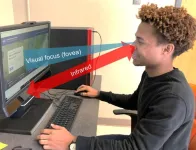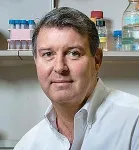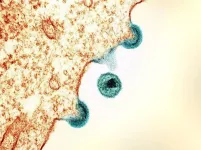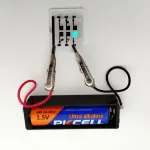(Press-News.org) Boulder, Colo., USA: The consequences of a warming climate frequently dominated the news this summer, from devastating wildfires and floods to deadly heat waves across the globe. Reducing harm from climate change is a challenging endeavor, and it requires comprehensive public education. Thus, the question arises: How can climate change science be made most accessible to the general population, as well as decision-makers and educators?
In a new paper published in the journal Geosphere, Steph Courtney and Karen McNeal explore the effects of improved data visualizations on user perception of climate change evidence.
With a geoscience background and a specialization in science education and communication, Courtney is passionate about improving the public’s understanding of climate change. “We get excited and carried away as scientists but that’s not going to work for a lot of audiences,” says Courtney. “Your communication goal is more important than how cool you think your graph is.”
In this study, the team redesigned three graphs from the Intergovernmental Panel on Climate Change (IPCC) Fifth Assessment Report. They assessed the impact of the redesign on graph usability (i.e. individuals’ ability to accurately and quickly extract information from it) and user perception of scientist trustworthiness and climate change risk, which correlate to both knowledge and intention to take action. The process was iterative, including two rounds of user testing and successive redesign and re-testing. Methods included a combination of surveys, eye-tracking, ranking activities, and interviews.
While the overall usability of the redesigned charts was found to be equivalent to that of the originals, study participants perceived all of the redesigned figures to be more trustworthy. Participants also reported one of the redesigns made them more concerned about climate change than the original.
An interesting question explored in this study was whether more simplistic figures would look “less scientific” and thus less trustworthy. Surprisingly, this did not turn out to be the case. “Pretty is fine,” explains Courtney. “If it looks nicer, it looks like you put time into it, so you care about it and you know what you are doing. Understandable and attractive graphs can be trustworthy. It is a win-win!”
The authors found that familiar figure formats were most useful; even minor changes to standard charts were confusing to the audience. Intentional use of color-coding was very important to participants, increasing both their understanding and perception of credibility. Likewise, minimal use of additional explanatory text on axes and fields greatly helped in those respects, although visual cluttering is a potential downside.
Graph redesign in this study was subtle, in order to be able to confidently parse out which change resulted in what improvement. Yet some of these changes were quite impactful. “Little changes that take just a bit of effort can make the science more accessible and meaningful to people. It is worth that little bit of effort. Communication is not the only barrier in addressing climate change, but it is an area we can stand to improve—and it is worthwhile,” emphasizes Courtney.
Courtney sees the future of this research field focusing on practical examples of climate scientists’ top priorities for public understanding of and actions to address climate change, perhaps attempting more dramatic graph edits. She will share her results with the IPCC and is looking forward to seeing their next assessment report.
FEATURED ARTICLE
Seeing is believing: Climate change graph design and user judgments of credibility, usability, and risk
S.L. Courtney and K.S. McNeal
Contact: Steph Courtney, scourtney@usetinc.org
https://doi.org/10.1130/GES02517.1
GEOSPHERE articles published ahead of print are online at https://pubs.geoscienceworld.org/geosphere/early-publication. Representatives of the media may obtain complimentary copies of articles by contacting Justin Samuel. Please discuss articles of interest with the authors before publishing stories on their work, and please make reference to GEOSPHERE in articles published. Non-media requests for articles may be directed to GSA Sales and Service, gsaservice@geosociety.org.
END
Effective visual communication of climate change
New study published in GEOSPHERE
2023-09-20
ELSE PRESS RELEASES FROM THIS DATE:
Clinical trial of HIV vaccine begins in United States and South Africa
2023-09-20
WHAT:
A trial of a preventive HIV vaccine candidate has begun enrollment in the United States and South Africa. The Phase 1 trial will evaluate a novel vaccine known as VIR-1388 for its safety and ability to induce an HIV-specific immune response in people. The National Institute of Allergy and Infectious Diseases (NIAID), part of the National Institutes of Health, has provided scientific and financial support throughout the lifecycle of this HIV vaccine concept and is contributing funding for this study.
VIR-1388 is designed to instruct the ...
Five new health systems partner with American Thoracic Society on vaccine initiative
2023-09-20
NEW YORK, NY – Sept. 20, 2023 – As cities brace for a confluence of flu, COVID-19, pneumonia, and RSV infections this fall, the American Thoracic Society announced that five new health systems have partnered with the Society to improve vaccination rates. Grady Health System (Atlanta, GA), Meharry Medical College (Nashville, TN), St. Luke’s Health System (Boise, ID), the University of Colorado (Aurora, CO), and Wayne Health (Detroit, MI) join the University of Arizona/ Banner Health, West Virginia University Hospitals, Inc., and San Francisco Health Network/ University of California to help identify barriers to vaccination and find ...
Mount Sinai receives $6.2 million grant from the Steven & Alexandra Cohen Foundation for the clinical care of long Lyme disease
2023-09-20
Mount Sinai’s Department of Rehabilitation and Human Performance has announced a $6.2 million grant from the Steven & Alexandra Cohen Foundation. The grant will expand the Cohen Center for Recovery From Complex Chronic Illnesses (CoRE) to encompass research and clinical care beyond long COVID to include “long Lyme Disease/Lyme+” as well as other infection-associated complex chronic illnesses.
This funding will be used for new research programs focusing on understanding and highlighting the key similarities and differences between long COVID; long Lyme disease/Lyme+, a collection of infection-associated ...
Citizen Science receives a significant boost
2023-09-20
There is a growing interest in incorporating assistance from private citizens into scientific projects globally. Nonetheless, it seems that Anders P. Tøttrup, an Associate Professor at the Natural History Museum of Denmark, might become the world's first professor in Citizen Science.
Anders P. Tøttrup is a trained biologist and leads the section for Citizen Science projects at the Natural History Museum of Denmark. These projects involve scientific endeavours in which citizens are invited to assist in collecting and analyzing data. Now, the Museum is taking a step further as Anders P. Tøttrup enters a 'professor track.' The goal is ...
Urban light pollution linked to smaller eyes in birds
2023-09-20
PULLMAN, Wash. – The bright lights of big cities could be causing an evolutionary adaptation for smaller eyes in some birds, a new study indicates.
Researchers found that two common songbirds, the Northern Cardinal and Carolina Wren, that live year-round in the urban core of San Antonio, Texas, had eyes about 5% smaller than members of the same species from the less bright outskirts. Researchers found no eye-size difference for two species of migratory birds, the Painted Bunting and White-eyed Vireo, no matter which part of the city ...
Novel organic light-emitting diode with ultralow turn-on voltage for blue emission
2023-09-20
An upconversion organic light-emitting diode (OLED) based on a typical blue-fluorescence emitter achieves emission at an ultralow turn-on voltage of 1.47 V, as demonstrated by researchers from Tokyo Tech. Their technology circumvents the traditional high voltage requirement for blue OLEDs, leading to potential advancements in commercial smartphone and large screen displays.
Blue light is vital for light-emitting devices, lighting applications, as well as smartphone screens and large screen displays. However, it is challenging to develop efficient blue organic light-emitting diodes (OLEDs) ...
Canadian older adults with COPD faced high levels of depression during the COVID pandemic
2023-09-20
A new longitudinal study published online in the International Journal of Chronic Obstructive Pulmonary Disease found that older adults with COPD had a heightened risk of depression during the early stages of the COVID-19 pandemic.
Researchers examined a sample of 875 individuals with COPD from the Canadian Longitudinal Study on Aging, a national study of Canadian older adults. Using longitudinal data, researchers were able to differentiate between 369 respondents with COPD who had a pre-pandemic history of depression and 506 respondents who had never experienced ...
Targeting Epstein-Barr virus to treat and prevent MS
2023-09-20
Recent evidence strongly implicates infection by the Epstein-Barr virus (EBV) as the trigger for development of multiple sclerosis (MS). An international research team is now gathering to unveil the role of EBV in the onset and progression of the MS disease.
The team has ambitious goals:
“We aim to find out why only a few EBV infected people develop MS, and define the underlying mechanism of this process”, explains the principal investigator (PI), Professor Kjell-Morten Myhr of the University of Bergen.
“Our research will also seek to investigate if targeting the EBV infection with antiviral treatments can improve the disease course or even stop ...
Can cognitive-behavioral therapy lessen fibromyalgia pain?
2023-09-20
In a recent randomized clinical trial of patients with fibromyalgia, cognitive-behavioral therapy (CBT)—which uses structured techniques to alter distorted thoughts and negative moods—was superior to a matched education treatment in reducing the interfering effects of pain and other aspects of fibromyalgia on daily living.
Within the group that received CBT in the trial, which is published in Arthritis & Rheumatology, improvements were at least partly attributable to reductions in what’s known as catastrophizing, a state comprised of cognitive and emotional processes such as helplessness, rumination, and magnification of ...
Can creatine supplements help people suffering from post-COVID-19 fatigue?
2023-09-20
The amino acid creatine is essential for muscle and brain health, and people commonly use creatine supplements to improve exercise performance and increase muscle mass. Results from a recent clinical trial published in Food Science & Nutrition indicate that dietary creatine may also benefit individuals experiencing post-COVID-19 fatigue syndrome (also known as long COVID).
In the trial, 12 people with post-COVID-19 fatigue syndrome were randomized to take a placebo or 4 grams of creatine monohydrate per day for ...
LAST 30 PRESS RELEASES:
Anxiety and insomnia may lower natural killer cell count, potentially repressing immune function
How parasitic, asexual plants evolve and live
Research spotlight: A subset of patients with depression could benefit from anti-inflammatory treatment
New fully digital design paves the way for scalable probabilistic computing
Membrane electrode assembly design for high-efficiency anion exchange membrane water electrolysis
U.S. debt ceiling disputes show measurable impact on global crude oil markets
Climate extremes triggered rare coral disease and mass mortality on the Great Barrier Reef
Direct observation reveals “two-in-one” roles of plasma turbulence
Humans rank between meerkats and beavers in monogamy ‘league table’
US fossil reveals early mass-burial event and ancient microbial attack
Sedative choice could improve outcomes for breathing tube patients
New superconducting thin film for quantum computer chips
Simulations reveal protein "dynamin" constricts cell membranes by loosening its grip
Nearly 1 in 5 UK emergency department patients cared for in corridors/waiting rooms
Heavy energy drink intake may pose serious stroke risk, doctors warn
Violence against women and children among top health threats: New global study reveals disease burden far larger than previously estimated
Predicting who is at risk of developing type 1 diabetes, as new drugs now available
New gene-mapping method unlocks hidden drivers of cancer
Ocean current and seabed shape influence warm water circulation under ice shelves
Call to increase funding for ‘invisible’ Deaf victim-survivors of domestic abuse
University of Maryland School of Medicine names distinguished scientist and academic leader Gerald M. Wilson, PhD, as Chair of the Department of Biochemistry and Molecular Biology
Receptors in mammary glands make livestock and humans inviting hosts for avian flu
Icy hot plasmas
Treating adults with autism: Maryland Clinical Center offers national blueprint for care after pediatric transition
University of Phoenix College of Doctoral Studies releases white paper on reclaiming control to build workforce resilience
NCCN Summit seeks to improve care for veterans and first responders with cancer from line-of-duty exposure
ERC Consolidator Grant for soft robotics researcher
Dual-action arts and wellbeing program transforms dementia care
The global plastic waste trade contributes to coastal litter in importing countries, study shows
UT Dallas partners with Tech Mahindra on AI innovation
[Press-News.org] Effective visual communication of climate changeNew study published in GEOSPHERE








